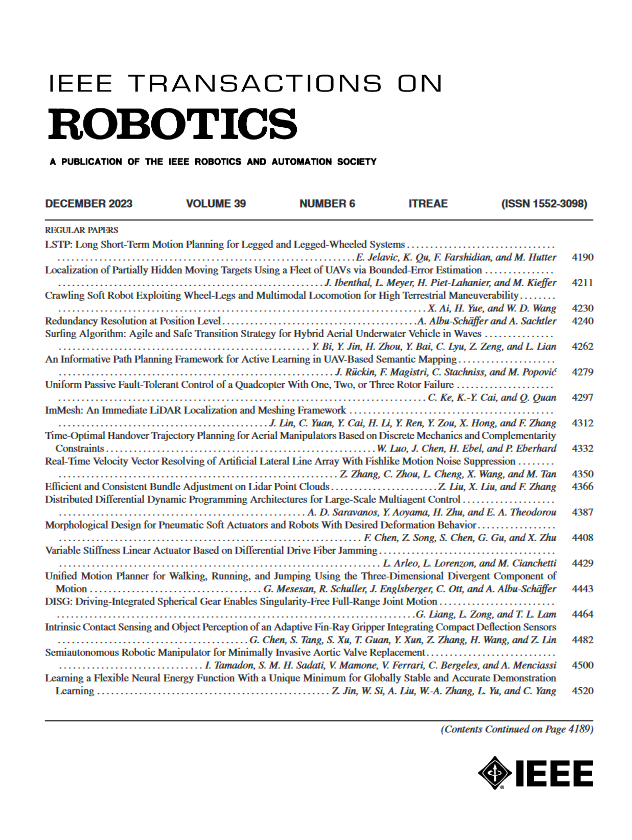用于软机器人的3d打印无折痕折纸真空弯曲驱动器
IF 10.5
1区 计算机科学
Q1 ROBOTICS
引用次数: 0
摘要
虽然基于真空的弯曲驱动在软机器人中具有安全性和紧凑性等优点,但由于其有限的驱动压力,它经常被忽视,这限制了弯曲角度和力输出。本研究提出了一种无折痕、折纸启发的真空弯曲致动器,它通过优化刚度分布引入有序的自折叠,在最先进的真空弯曲致动器和传统折纸变形原理的基础上进行了改进。通过有限元方法实现,这种设计具有以下几个优点:1)自折叠允许在紧凑的形式下实现高弯曲角度(高达138$^{\circ}$)。2)无折痕设计便于使用消费者级熔融长丝制造打印机从单一柔软材料进行3d打印,特别是具有60 a邵氏硬度的热塑性聚氨酯,具有更高的灵活性和耐用性。3)紧凑的结构使模块化设计成为可能,可在适应性运动软机器人中进行重构。4)与其他设计相比,大弯曲角度允许执行器环绕物体,提供广泛的接触。这种能力与真空驱动机制相结合,可以与章鱼状真空抓取器中的自闭吸盘协同作用,为处理从小的不规则形状到大的扁平物体提供大的通用性和抓取力。本文章由计算机程序翻译,如有差异,请以英文原文为准。
3D-Printable Crease-Free Origami Vacuum Bending Actuators for Soft Robots
While vacuum-based bending actuation offers benefits such as safety and compactness in soft robotics, it is often overlooked due to its limited actuation pressure, which restricts both bending angle and force output. This study presents a crease-free, origami-inspired vacuum bending actuator that advances both state-of-the-art vacuum bending actuators and traditional origami deformation principles by introducing orderly self folding through optimized stiffness distribution. Achieved through finite element method, this design provides several advantages: 1) Self-folding allows for high bending angles (up to 138$^{\circ }$
求助全文
通过发布文献求助,成功后即可免费获取论文全文。
去求助
来源期刊

IEEE Transactions on Robotics
工程技术-机器人学
CiteScore
14.90
自引率
5.10%
发文量
259
审稿时长
6.0 months
期刊介绍:
The IEEE Transactions on Robotics (T-RO) is dedicated to publishing fundamental papers covering all facets of robotics, drawing on interdisciplinary approaches from computer science, control systems, electrical engineering, mathematics, mechanical engineering, and beyond. From industrial applications to service and personal assistants, surgical operations to space, underwater, and remote exploration, robots and intelligent machines play pivotal roles across various domains, including entertainment, safety, search and rescue, military applications, agriculture, and intelligent vehicles.
Special emphasis is placed on intelligent machines and systems designed for unstructured environments, where a significant portion of the environment remains unknown and beyond direct sensing or control.
 求助内容:
求助内容: 应助结果提醒方式:
应助结果提醒方式:


